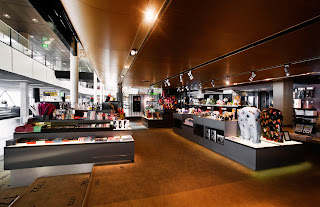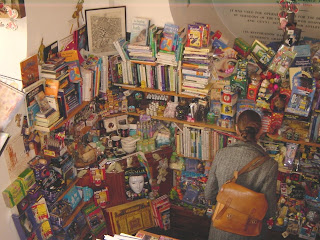 |
| Innovative Retail Techniques in Museum Shops |
Simon Neville of the Guardian writes
'Think about a museum shop and the image that springs to mind is unlikely to be inspiring. An unavoidable obstacle, blocking the exit, stuffed with an assortment of overpriced teapots, wearisome books and a collection of plastic rulers, pencils adorned with tassels and cheap notepads masquerading as special mementoes.
But thanks to a combination of the financial crisis, government cuts and the changing landscape of Britain’s high street, museum and gallery shops are turning into thriving commercial hubs, generating sales of £100m last year.'
This may have been true of some museums in the past and may still be in some cases. But what he should be saying is that many privately owned (including charitable trusts) museums/visitor attractions have been driving secondary spend up ie retail and catering sales for years. They have had to do so as they have received little or no funding from the public purse. Many heritage railways for example have had thriving traditional and 'on line' shops for many years, the Welsh Highland Heritage Railway bookshop at Porthmadog, North Wales being just one small example.
Neville in his
article goes on to say - 'As cuts have hit arts funding hard, the answer for many museums has been to raise their retail game – by moving upmarket. At the Victoria & Albert Museum, for example, a vast array of David Bowie paraphernalia is on sale, linked to the new exhibition. How about a limited edition of Terry O’Neill’s famous Bowie and rearing dog publicity shot for the Diamond Dogs album, signed by the photographer, for £4,800? Or a print of the Ziggy Stardust album cover for £2,250? Too much?
At the other end of the price scale is a guitar pick, with an image of Bowie as Aladdin Sane on one side and the pattern from one of his 1970s jumpsuits on the other for a mere 75p.
 |
| Shop at Victoria & Albert Museum |
John Stachiewicz, chairman of the Association for Cultural Enterprises, said: “Cuts in the cultural sector have been deep since the recession hit and institutions have quite simply had to rise to the challenge. One of the ways we have witnessed the sector doing this is by creating unique and relevant products to sell to visitors.”
Some of the more creative items appear to have been thought up in several eureka moments. St Paul’s Cathedral harvested some of the rubble from recent refurbishments and set it into cufflinks. For £210 owners can now decorate their shirt cuffs with marble from the starburst under its famous dome.
Over at the National Theatre shop, the success of Warhorse – turned into a film directed by Steven Spielberg – led to the offer of a £2,500 half-size replica of the geese puppets used in the stage show, created by the puppeteers who made the originals.
At the Science Museum, shoppers can buy vases shaped as Thomas Edison’s iconic light bulb, made from recycled incandescent bulbs. The museum has asked its inventor in residence,
Mark Champkins, to create more unique items for it to sell.
However, perhaps leading the way in terms of creativity is the
London Transport Museum in Covent Garden. To celebrate London Underground’s 150th anniversary, the creative heads there have salvaged luggage racks from old Metropolitan line trains – selling them for £250.
Mike Walton, head of trading at the museum, says the best-selling items include wallets and bags made from off-cuts of the fabric used on the seats of tube trains and buses.
He said: “The fabrics are ingrained into the subconscious of Londoners, but the patterns are distinctive and immediately recognisable. They have been so popular that we’ve even started selling cushions and rugs in the same patterns as the Victoria line seats or old Routemaster bus seats.”
The increase in the variety and range of products has meant sales topped £2.5m last year, with Christmas trading up 15% in store and 47% online. All profits are pumped back into the museum. A new website, which includes the entire digital archive of 5,000 transport posters from 1908, means online sales now make up 20% of total revenues.
Walton, who has worked at LTM for more than 30 years, said: “Having a shop used to be a necessary evil for many museums. It’s always been much more about the institution itself, and the commercial activities were seen as a sideshow with no great interest to those who ran the museums.
“We were near the bottom of the pile in terms of importance. But now it has become vital for virtually all cultural institutions, whether they are in the public domain or independent, to raise more and more money as government and local authority grants dry up. So, in order to thrive and prosper, our operations are now absolutely essential.”
 |
| London Transport Museum Shop |
As well as the cuts to the Department for Culture, Media and Sport and Arts Council, local authorities have also wielded the axe to cultural projects in order to protect other spending. Manchester city council is planning a 10% cut to cultural grants to save £390,000, while in Sheffield, the local authority is cutting 8%, affecting its Crucible and Lyceum theatres. Most controversially, Newcastle city council planned to scrap its entire £1.2m arts grant to local theatres, galleries and museums. It performed a U-turn at the last moment following an intervention by Harriet Harman, but not before cutting funding by 50%.
Jon Walker, trading manager at Tyne and Wear Archives and Museums, which runs 10 institutions across the north-east including the Laing Art Gallery and Discovery Museum, said: “We are all currently experiencing funding pressures. We have always generated our own income, through retail sales, catering, venue hire and e-commerce, but the need to fully exploit these opportunities is now greater than ever.
“The sharpest increase has been generated from venue hire. Corporate clients are taking the opportunity to use the fantastic spaces that we have available in our museums and galleries.
“The increased pressure on us to generate cash has mean we are now far more flexible with the use of our spaces. For example, you can now get married at the Laing Art Gallery on a Saturday afternoon, an opportunity we hadn’t even considered offering a few years ago.”
It is these unique experiences and products that appear to have given museum and gallery shops a much-needed boost, mixed with a combination of the high street decline and a desire from shoppers to buy from local cultural landmarks. Stachiewicz said: “I believe that the generic and homogenous nature of our high streets has been displaced by the unique variety we now have to offer in museum and art gallery shops.
“Up until fairly recently, we had these extraordinary venues not running their commercial enterprises to the best of their ability.
“Stuff was quite simply piled up in the shops and service in the restaurants and cafes was somewhat homespun and of varying degrees of quality.”
 |
| The Shop at The Old Operating Theatre Museum London
|
An interesting example of a small museum shop is that at The
Old Operating Theatre Museum in London.
Denise Barrett's review of the Museum for 'Health Matters' complimented it as
being "like a mini V and A shop"...hmmm! They have health and medicine as the
theme of the Shop but also have items of more general interest. A good supply
of books on the history of medicine and on herbal medicine; lots of
idiosyncratic science toys and games including biros mascarading as syringes; tee-shirts,
guide books, information sheets and books on local history.
But now, as a result of institutions improving their offering, takings topped £1bn last year from membership, admission, sponsorship, corporate hire and retail sales – with the shops alone taking around £100m.
It is not just the museums and galleries that are benefiting from the growth in sales, as many of the gifts are now sourced from British manufacturers and suppliers. At the transport museum, Walton explained that the moquette fabric is produced in Yorkshire, with the offcuts added to bags and purses at factories in Shropshire. New furniture made from the fabric is produced in Nottinghamshire.
Production has doubled in the last three years as a result, while porcelain memorabilia adorned with transport motifs are once again being made in Stoke .
Walton said: “Customers are becoming more interested in knowing where things are being made, so while we would in the past have used suppliers from Asia and Turkey, we have shifted much of that back to the UK.”
With further government spending cuts expected – last month officials hinted that the comprehensive spending review due in the summer could include another 10% budget cut to each department – the demands on cultural institutions to raise more of their own cash can only intensify. That is a big ask for museums and galleries when their visitors’ budgets are also strained – but one welcome side effect is that at least the grim shops blocking the exit have improved.'
One example of a museum shop that has been transformed with some innovative merchandising including new lighting and a bit of help from Arts Council money is at Coventry's Herbert Museum & Art Gallery. Here with dedicated staff (most important) and better buying, both margins and sales are on the increase. One product tactic that has paid off is commissioning short runs of well priced jewellery from local suppliers.
At the British Postal Museum & Archive, the commercial team working as Postal Heritage Services Ltd is preparing to develop the licensing and product opportunities arising from the new museum and Mail Rail project by exploiting the huge amount of unique intellectual property in the archive - and it's not just stamps!
 |
| BPMA On line Shop |
One thing that museums who operate as charitable trusts need to be aware of is to trade through a separate but wholly owned subsidiary. This both protects their integrity as charitable trusts in the eyes of the Charity Commission and the law and allows the Trust to claim gift aid from the surplus that the trading company (hopefully) donates to the trust each year. Finally both trusts and their trading companies need some 'commercially savvy' trustees and directors who can provide the necessary strategic direction.
One of the other aspects of museum shops is of course positioning and display, driving the visitor past the merchandise as they leave and also having a variety of product available at different price points.
For more information on generating income and secondary spend
contact Attract on 01926 864 900 or drop an email to
nick@attractmarketing.co.uk
Thanks and copyright acknowledgements to The Guardian and Simon Neville whose article inspired this blog and to
www.government-online.net where my colleague Janet Lang found it.






